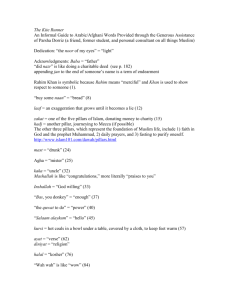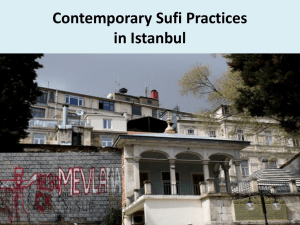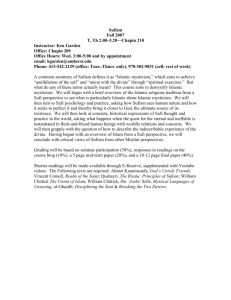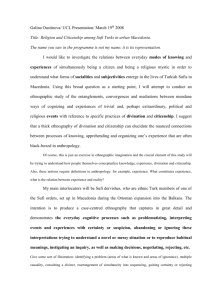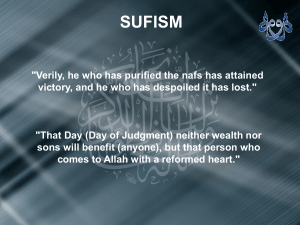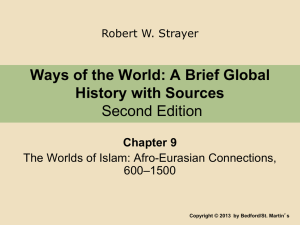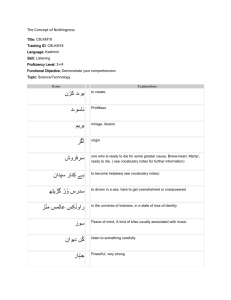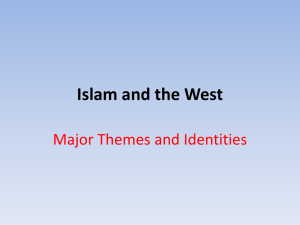Categories of Scholarship on Sufism
advertisement
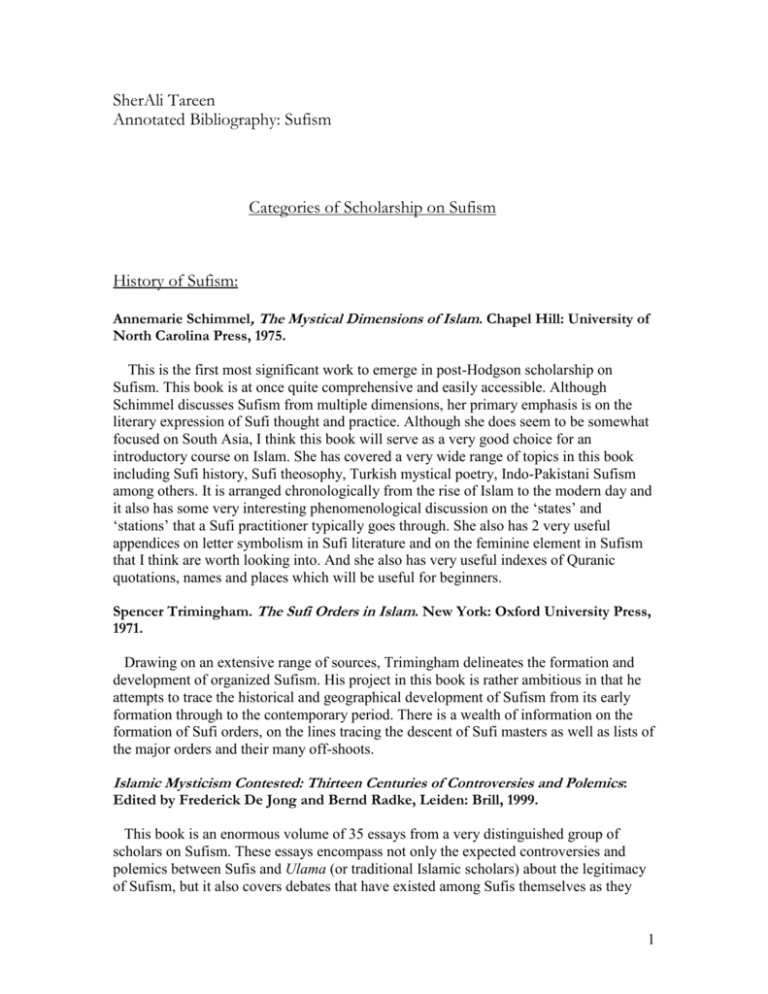
SherAli Tareen Annotated Bibliography: Sufism Categories of Scholarship on Sufism History of Sufism: Annemarie Schimmel, The Mystical Dimensions of Islam. Chapel Hill: University of North Carolina Press, 1975. This is the first most significant work to emerge in post-Hodgson scholarship on Sufism. This book is at once quite comprehensive and easily accessible. Although Schimmel discusses Sufism from multiple dimensions, her primary emphasis is on the literary expression of Sufi thought and practice. Although she does seem to be somewhat focused on South Asia, I think this book will serve as a very good choice for an introductory course on Islam. She has covered a very wide range of topics in this book including Sufi history, Sufi theosophy, Turkish mystical poetry, Indo-Pakistani Sufism among others. It is arranged chronologically from the rise of Islam to the modern day and it also has some very interesting phenomenological discussion on the ‘states’ and ‘stations’ that a Sufi practitioner typically goes through. She also has 2 very useful appendices on letter symbolism in Sufi literature and on the feminine element in Sufism that I think are worth looking into. And she also has very useful indexes of Quranic quotations, names and places which will be useful for beginners. Spencer Trimingham. The Sufi Orders in Islam. New York: Oxford University Press, 1971. Drawing on an extensive range of sources, Trimingham delineates the formation and development of organized Sufism. His project in this book is rather ambitious in that he attempts to trace the historical and geographical development of Sufism from its early formation through to the contemporary period. There is a wealth of information on the formation of Sufi orders, on the lines tracing the descent of Sufi masters as well as lists of the major orders and their many off-shoots. Islamic Mysticism Contested: Thirteen Centuries of Controversies and Polemics: Edited by Frederick De Jong and Bernd Radke, Leiden: Brill, 1999. This book is an enormous volume of 35 essays from a very distinguished group of scholars on Sufism. These essays encompass not only the expected controversies and polemics between Sufis and Ulama (or traditional Islamic scholars) about the legitimacy of Sufism, but it also covers debates that have existed among Sufis themselves as they 1 have struggled for political power and authority to define “true” Sufism. This volume provides a very comprehensive overview of not only the theological, historical and institutional issues that are pertinent to the study of Sufism, but it also gives a good sense of the various contemporary scholarly approaches that are being implemented in studying Sufi thought and practice. Institutional Sufism: Arthur Buehler. Sufi Heirs of the Prophet: The Indian Naqshbandiyya and the Rise of the Mediating Sufi Shaykh. Columbia: University of South Carolina Press, 1998. Sufi Heirs of the Prophet: The Indian Naqshbandiyya and the Rise of the Mediating Sufi Shaykh is an important contribution to the study of the Naqshbandi Sufi order that originated in Central Asia and is today one of the major Sufi orders in South Asia and elsewhere. Buehler has discussed the ways in which the Naqshbandis have gone about linking themselves to the legacy of the Prophet. The focus of his study is on the role of the Shaykh (Sufi master) in the history of Sufism with particular references to Sufi understandings of Muhammad’s personality and functions. Buehler’s study is very useful in that it covers an area of Islamic studies that is quite applicable in a variety of different contexts, this whole idea of Muhammad’s significance in Islam both for his role as the religion’s historical founder and as the exemplary model emulated by Muslims in different ways. This book is also useful in understanding the processes involved in the geographic movement of a Sufi order from one place to another. In the first half of this book, Buehler spends quite some time discussing the movement of Naqshbandi Sufis from Central Asia to India in the 16th century an how these newly arrived Sufi masters went about adapting their worldview according to the new environment that they found themselves in. Buehler also does a good job of talking about some of the most distinguishing features of Naqshbandi Sufis such as an emphasis on a living-directing Shaikh instead of an emphasis on the veneration of deceased masters, the importance of genealogies and spiritual chains (silsilas) in the evolution of religious authority and so forth. But overall, this book is most significant in providing a useful theoretical approach to studying the interrelation between the symbolism of Muhammad’s example and the articulation of Sufi religious authority. Carl Ernst. Eternal garden: Mysticism, History and Politics at a South Asian Sufi Center. Albany: State University of New York Press, 1992. This is another important work on institutional Sufism that takes place in the Chishti shrine of Khuldabad in Northern India. The Chishtis are perhaps the most significant Sufi order in both pre-modern and contemporary South Asia. The first part of this book provides a detailed overview of the methodological and historiographic issues that are important in the study of Sufism and of Islam in India. There is a discussion on the problems associated with both Indian and Pakistani nationalist historiographies, mainly the problem of projecting a strictly positivist attitude towards doing history. And then 2 there are 2 separate chapters on medieval Islamic views of India and medieval Indian views of Islam that are also very helpful in giving some sense of the intellectual issues involved in studying South Asian Islam. The focus of this book though is on the social and political history of the Khuldabad Chishtis in the Indian Deccan, especially as it relates to the institutional practices associated with a Sufi master by the name of Burhan ad-Din Gharib (d.1337), who was a disciple of another very famous Indian Sufi by the name of Nizam ad-Din Awliya. From a methodological standpoint, this book is significant in that it really brings to light some of the major ways in which a Sufi order can serve as a potent force for legitimizing spiritual and political authority, and how that process of legitimization takes place within a local context, which in this case is Northern India. In this respect, Eternal Garden really brings to focus some of the ways in which mysticism and politics intersect, and how that intersection defines the communal identity of a given Sufi order, which in this case are the Chishtis of Khuldabad. Another important contribution of this book is its demonstration that the early Sufi works that are associated with the Khuldabad Chishtis are very strongly grounded in classical Islamic learning, and it thus problematizes the overly simplistic idea of these medieval Sufis being these syncretic folksy types who were completely disengaged from the classical Islamic tradition. So regardless of your level of interest in Indian Sufism, this book does serve as a useful pedagogical tool to talk about some of these important issues that apply to the study of Sufism in general. Social-Scientific/Ethnographic Studies of Sufism Valerie Hoffman. Sufism, Mystics and Saints in Modern Egypt. Columbia: University of South Carolina Press, 1995. Sufism, Mystics and Saints in Modern Egypt is an extraordinary ethnographic study of Sufism in modern Egypt. Valerie Hoffman conducted extensive and active field-research as a young mother with a nursing child in tow. A lot of Hoffman’s discussion in this book is very imaginative and also quite personal, as she talks about her relationship with a Shaikh in Cairo, and the dynamics of this master-disciple relationship despite the author not being Muslim. Hoffman also emphasizes and indeed argues for the continuity between classical Islam and contemporary Sufism in Egypt. In addition to showing a strong connection between Classical Islam and modern Egyptian Sufism, Hoffman has further argued that the scriptural basis for contemporary Sufism is provided by the Sufism that prevailed between the eighth through the thirteenth centuries. In a somewhat similar fashion to Arthur Buehler’s argument about the Naqshbandi Sufis in India, Hoffman also focuses on the importance of devotion to the Prophet’s family in contemporary Egyptian Sufism. Hoffman also has a very interesting discussion on issues of women and sexuality in Sufi life, the only such discussion that I came across in the books on contemporary Sufism that I surveyed. 3 Katherine Ewing. Arguing Sainthood: Modernity, Psychoanalysis and Islam. Durham [N.C.]: Duke University Press, 1997. This is an anthropological analysis of Sufis located in Lahore, Pakistan. Methodologically, Ewing’s approach is quite novel in that she has uses Lacan’s psychoanalytic theory to investigate psychological processes embedded in the relationship between Sufi masters (or Pirs) and their mostly middle-class Pakistani clients. So in some ways, arguing sainthood is an exploration of the complexities and contradictions of middle-class religion in Lahore, Pakistan. She discusses in some depth the intersections of black magic, Sufism, political ideology, and religion. She also documents the ways in which the modern state of Pakistan has been seeking to control popular Sufism, often by taking over several of the most lucrative and popular shrines. So Ewing has demonstrated that Pakistan represents a very effective case study to analyze the ways in which a state might intervene in the functionality of Sufi masters to serve as spiritual mediators between humans and God. So instead of calling these Sufi masters spiritual mediators you can call them poets, social reformers or educated scholarsanything that diminishes that meditative functionality. Another noteworthy and perhaps the most applicative aspect of Ewing’s work relates to her discussion on the ways in which Pakistanis negotiate the clash between modern rationality and traditional superstition. Another theme that runs throughout Ewing’s work is the contradictions between public and private personas as held by clients of the Sufi Pirs. For instance, in one of her case studies she talks about a woman who felt that her life had been transformed by a cure affected by a Sufi Pir but then she goes on to accuse him of being a fraud. But I think Ewing’s ethnographic/psychoanalytic methodology allows her to explain such contradictions in a very effective fashion. Sufism and Metaphysics William C. Chittick. The Sufi Path of Knowledge: Ibn al-Arabi’s Metaphysics of Imagination. Albany: State University of New York Press, 1989. William Chittick is perhaps the most prolific scholar on Ibn al-Arabi (1165-1240), who is widely recognized as one of the most if not the most influential mystical thinkers in the history of Islam. There are very few areas of Islamic thought and spirituality where you do not find some trace of Ibn al-Arabi’s influence. Originally from Andalusia, he spent time in North Africa, Anatolia, Mecca and eventually died in Syria. The Sufi Path of Knowledge is a very comprehensive and detailed exposition of Ibn al-Arabi’s life and thinking. It is meant to be an introductory book on Ibn al-Arabi’s metaphysics but some of the discussion in this book is quite technical and dense. The crux of his argument in is quite apparent from the title, mainly that Ibn al-Arabi’s metaphysics cannot be understood without reference to his view of imagination, and his view of imagination cannot be grasped without internalizing his metaphysics. And I think for the purposes of an introductory course on Islam, one can get a decent flavor of Chittick’s argument by going through the first chapter which is appropriately called 4 ‘overview’ in which Chittick argues that Ibn al-Arabi was chiefly concerned with the idea of divine unity. And he has done a good job of summarizing Ibn al-Arabi’s understandings of such critical concepts as divine acts, divine attributes, human perfection and so forth. The rest of the chapters are entitled ‘ontology, ‘epistemology’, ‘Hermeneutics’, ‘soteriology’ and consummation. But again I think for an intro level course chapter 1 is really more than enough to acquire a workable understanding of the metaphysical concerns that drove Ibn al-Arabi’s writings. Sufism and Gender Ahmed T. Karamustafa. God’s Unruly Friends: Dervish Groups in the Later Middle Period: 1200-1550. Salt Lake City: University of Utah Press, 1994. This is a highly fascinating book on Sufism in Ottoman Turkey between the thirteenth and mid-sixteenth centuries. Basically this book is an interpretive analysis of antinomian Dervish groups that existed on the peripheries of both organized Sufism and the broader society in general. Introductory Books on Sufism: Carl W. Ernst. Guide to Sufism. Boston: Shambhala Publications, 1997. William Chittick. Sufism: A Short Introduction. Boston: One-world Publications, 2000. Alexander Knysh. Islamic Mysticism: A Short History. Leiden, Brill. 2000. Other Widely Cited Works Michael Sells. trans., Early Islamic Mysticism, Classics of Western Spirituality. Mahwah, NJ: Paulist Press, 1996. John Renard. trans., Knowledge of God in Classical Sufism: Foundations of Islamic Mystical Theology, Classics of Western Spirituality Mahwah, NJ: Paulist Press, 2004. The Heritage of Sufism, vol. 1, Classical Persian Sufism from its Origins to Rumi (700-1300), ed. Leonard Lewisohn. 5 Louis Massignon. The passion of al-Hallaj: mystic and martyr of Islam, trans. Herbert W. Mason Princeton, N.J.: Princeton University Press, 1982. Alexander D. Knysh. Ibn 'Arabi in the Later Islamic Tradition: The Making of a Polemical Image in Medieval Islam, SUNY Series in Islam. Albany: State University of New York Press, 1999. Michael Sells. Mystical Languages of Unsaying. Chicago: University of Chicago Press, 1994. William C. Chittick. Faith and practice of Islam: three thirteenth century Sufi Texts . Albany: State University of New York Press, 1992. Carl W. Ernst and Bruce B. Lawrence. Sufi Martyrs of Love: Chishti Sufism in South Asia and Beyond. New York: Palgrave Press, 2002. Carl W. Ernst. Words of Ecstasy in Sufism. Albany: State University of New York Press, 1985. Shemeem Burney Abbas. The Female Voice in Sufi Ritual: Devotional Practices of Pakistan and India. Austin, Texas: University of Texas Press, 2002. Shahzad Bashir. Messianic hopes and mystical visions: the Nūrbakhshīya between medieval and modern Islam. Columbia: University of South Carolina Press, 2003. Jamal Elias. The throne carrier of God: the life and thought of Alā ad-Dawla as-Simnānī. Albany: State University of New York Press, 1995. 6 Cyber Sufism: For a detailed listing of Sufi websites, go to http://www.unc.edu/depts/sufilit/links.htm. http://www.ibnarabisociety.org/index.html http://www.uga.edu/islam/Sufism.html http://www.armory.com/~thrace/sufi/ http://www.hayatidede.org/links.htm http://www.naqshbandi.com/ http://www.chishti.ru 7 8
